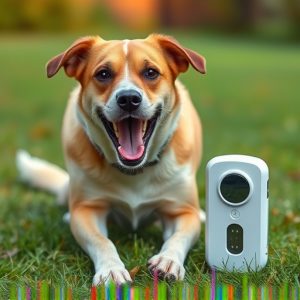Safe Dog Deterrents: Ultrasonic Systems for Effective Behavior Modification
Canine behavior modification ultrasonic systems safely deter unwanted dog behaviors by emitting inau…….
Canine behavior modification ultrasonic systems safely deter unwanted dog behaviors by emitting inaudible, high-frequency ultrasound (25-64 kHz) at 30-60 dB. These non-harmful signals teach dogs to avoid specific areas or actions without causing harm to humans or animals. With adjustable intensity levels and regular calibration, these systems promote peaceful coexistence between pets and their environments, offering a humane alternative to shock collars for responsible pet ownership.
“Unleash the power of behavior modification with the innovative Canine Behavior Modification Ultrasonic System. This article delves into the science behind canine behavior, exploring how ultrasonic technology can be a game-changer in training. We dissect the role of safe power levels, ensuring a human-friendly approach, and uncover the science behind effective dog deterrent systems.
Learn about the benefits, considerations, and practical applications of this method, offering a comprehensive guide for responsible and successful canine behavior modification.”
- Understanding Canine Behavior and the Role of Ultrasonic Systems
- Safe Power Levels: Ensuring a Human-Friendly Approach
- How Dog Deterrent Ultrasonic Systems Work Effectively
- Benefits and Considerations for Implementing This Modification Technique
Understanding Canine Behavior and the Role of Ultrasonic Systems
Canine behavior modification has become an essential aspect of responsible pet ownership, focusing on training dogs to exhibit desired behaviors and curb unwanted actions. Understanding canine behavior involves recognizing that dogs respond well to positive reinforcement, consistency, and structured routines. They are highly sensitive to their environment and can be influenced by various stimuli, including sound.
Ultrasonic systems have emerged as a safe power-level dog deterrent, leveraging high-frequency sounds that are inaudible to humans but irritating to canines. These systems emit precise ultrasonic tones when a dog approaches or interacts with a specific area, effectively redirecting their behavior without causing harm. By employing this technology, pet owners can train their dogs to avoid certain zones or behaviors, promoting a peaceful coexistence between pets and their environments.
Safe Power Levels: Ensuring a Human-Friendly Approach
When designing and implementing a canine behavior modification ultrasonic system, one of the paramount considerations is maintaining safe power levels to ensure it’s human-friendly. These systems use high-frequency sound waves to communicate with dogs, but it’s crucial to limit the power output to avoid potential harm to both humans and animals. Exceeding safe power levels can lead to discomfort or even physical injury for people nearby, as well as causing stress or anxiety in pets.
The optimal power levels for dog deterrents are typically well below the threshold that would cause pain or permanent damage. Professional systems usually operate within 30-60 decibels (dB), which is similar to the volume of a quiet conversation. This range is safe for humans while effectively training dogs by providing a gentle but noticeable stimulus. Regular testing and calibration ensure the system functions at these safe power levels, contributing to positive interactions between people and pets in various environments.
How Dog Deterrent Ultrasonic Systems Work Effectively
Dog deterrent ultrasonic systems are designed to modify canine behavior through the use of sound, specifically high-frequency ultrasound that is inaudible to humans. These systems emit safe power levels of ultrasonic waves, typically ranging from 25 to 64 kHz, which dogs perceive as an unpleasant sensation. Unlike traditional shock collars, ultrasonic deterrents do not cause physical harm or discomfort to the animal; instead, they rely on acoustic signals to communicate unwanted behavior.
When a dog approaches a protected area, the system detects its presence and immediately releases a burst of ultrasound. This sound is designed to be annoying but not harmful, causing the dog to pause and reconsider its actions. Over time, the dog learns to associate certain areas or behaviors with this unpleasant sensation, leading to desired behavioral changes. The key to their effectiveness lies in the safe power levels and specific frequency ranges, ensuring that both humans and pets remain undisturbed while training takes place.
Benefits and Considerations for Implementing This Modification Technique
Implementing a canine behavior modification ultrasonic system offers several benefits for pet owners and trainers looking to address unwanted behaviors in dogs. One of the key advantages is its non-violent nature; this method uses safe power levels of ultrasonic sound waves to deter dogs from specific actions, making it a humane alternative to traditional punishment techniques. By emitting an unpleasant yet harmless noise, these systems can effectively train dogs to associate certain behaviors with an uncomfortable sensation without causing physical harm or distress.
When considering this modification technique, it’s essential to recognize its effectiveness in modifying various behaviors like barking, jumping on furniture, and pulling on leashes. Moreover, modern ultrasonic dog deterrents are designed to be highly sensitive and adjustable, allowing users to set the intensity level according to their dog’s sensitivity. However, responsible use is crucial; owners should ensure proper training and understanding of the system to avoid any potential anxiety or fear in their pets due to incorrect application.
The integration of canine behavior modification using ultrasonic systems offers a safe, non-violent approach to addressing unwanted behaviors. By understanding dog psychology and utilizing specific power levels, these systems effectively deter dogs without causing harm. As long as they are used responsibly, taking into account the benefits and considerations outlined in this article, dog deterrent ultrasonic systems can be a valuable tool for pet owners and professionals alike, promoting positive canine behavior in a human-friendly manner.


